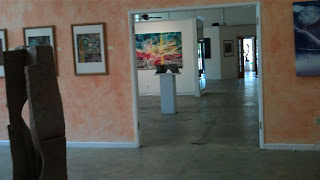To help support California state parks, I bought a membership which came with 7 free entrance passes to state parks. One thing I was surprised to find was that you have to pay to go into a park in California. As a result, many of them seem a bit vacant compared to the teaming number of people you will see at a state or county park in Iowa. It seems that Parks, like public libraries, should be available to everyone.
Only a stone's throw from Santa Cruz, is Henry Cowell Redwoods State Park. Seeing a grove of redwood trees should be on everyone's bucket list. It is truly an amazing thing. The trees can live to be 2000 years old, that puts you back to when Jesus was a teenager. I had my picture taken in front of the cross section of a tree at the entrance to the Redwood Grove Trail, a pleasant 20 minute walk. The tree it came from was stated to be 1000 years old.
As you walk among the redwoods, you look up up up and strain your neck and eyes to see the tops of these aged botanical giants. They are regal and silent and can grow to a magnificent 300 feet in height. The forest floor is cool in stark contrast to the paved parking lot you park in when you arrive.
The sequoia sempevirens, everliving redwood, is another name for the coast redwood. Tannic acid in the bark gives it a cinamon color.
Only a stone's throw from Santa Cruz, is Henry Cowell Redwoods State Park. Seeing a grove of redwood trees should be on everyone's bucket list. It is truly an amazing thing. The trees can live to be 2000 years old, that puts you back to when Jesus was a teenager. I had my picture taken in front of the cross section of a tree at the entrance to the Redwood Grove Trail, a pleasant 20 minute walk. The tree it came from was stated to be 1000 years old.
As you walk among the redwoods, you look up up up and strain your neck and eyes to see the tops of these aged botanical giants. They are regal and silent and can grow to a magnificent 300 feet in height. The forest floor is cool in stark contrast to the paved parking lot you park in when you arrive.
The sequoia sempevirens, everliving redwood, is another name for the coast redwood. Tannic acid in the bark gives it a cinamon color.





































